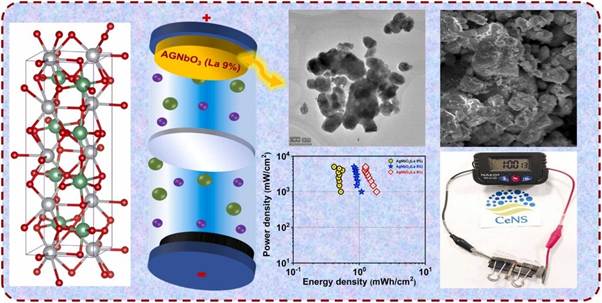




*Pic: Crystal configuration of Lanthanum-doped silver niobate and the photograph demonstrating the supercapacitor device successfully powering an LCD display
In a breakthrough that could redefine how we store and use energy, Scientists from Bengaluru, in collaboration with Aligarh Muslim University, have engineered a next-generation energy storage material that dramatically enhances supercapacitor performance.
At the heart of modern energy storage lies the supercapacitor—a device that can rapidly store and release large amounts of energy making them crucial for powering everything from mobile devices and electric vehicles to renewable energy systems. While faster than batteries, supercapacitors have often lagged behind in how much energy they can hold? Scientists have been exploring for materials that can increase storage without sacrificing speed or longevity.
A team of Indian researchers led by Dr. Kavita Pandey at the Centre for Nano and Soft Matter Sciences (CeNS), Bengaluru—an autonomous institute under the Department of Science and Technology (DST), Government of India, focused on silver niobate (AgNbO₃), a lead-free and environmentally friendly material with excellent electrical characteristics.
They injected lanthanum, a rare-earth element known for its beneficial electronic properties into silver niobate nanoparticles. This shrank the silver niobate nanoparticles particles allowing more surface area for energy storage.
The lanthanum improved the material’s ability to conduct electricity, thus speeding up the energy charge-discharge cycles. As a result of the lanthanum doping strategy, energy retention skyrocketed—the material retained 118% of its initial capacity after extensive use and efficiency hit perfection—with virtually no energy lost in use, giving 100% coulombic efficiency.
An asymmetric supercapacitor prototype was built with the material successfully powered an LCD display, hinting at real-world applications.
This research, published in the Journal of Alloys and Compounds, highlights the exciting potential of lanthanum doping as a strategy for tailoring the properties of silver niobate nanoparticles for high-performance supercapacitors. The findings enhance the promise of AgNbO₃ nanoparticles in electrochemical energy storage and showcase the important role of rare-earth doping in material innovation. Due to the global push for clean and efficient energy storage solutions, advancements like this are significant milestones.
By boosting energy density without compromising power output and stability, La-doped silver niobate can help pave the way for compact, high-efficiency storage devices suitable for both portable electronics to large-scale renewable energy systems. Looking ahead, future research will explore doping strategies in other perovskites and work towards scaling up the production of lanthanum-doped silver niobate components to ensure commercial feasibility.
Story credit PIB



